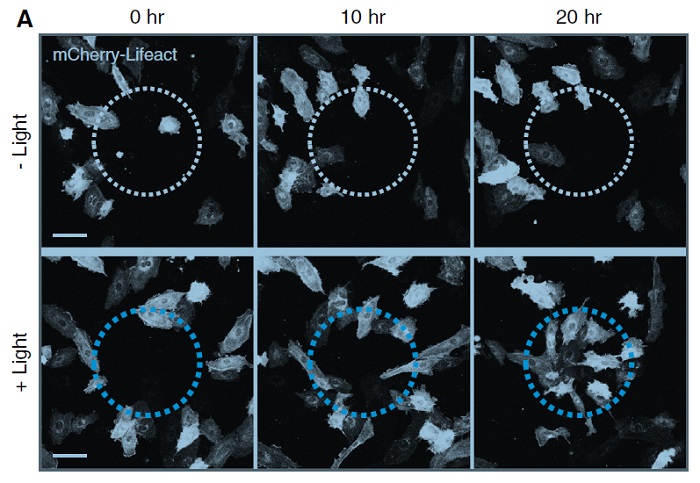Two teams of scientists have recently made two separate breakthrough discoveries in biology and physics.
First, in biology, a research team led by Professor Heo Won-do of the Korea Advanced Institute of Science and Technology (KAIST) found that the signaling of intracellular fibroblast growth factor receptors (FGFRs) can be controlled by illumination with a blue light.

Fibroblast growth factors, or FGFs, are heparin-binding proteins that play a key role in the process of proliferating cells and tissues and allowing them to function. The receptors, FDFRs, are highly sensitive receptor cells made out of tyrosine kinases that transmit external signals to inside the cell.
To date, only chemically based approaches have been used in the study of FGFR signaling pathways. Such methods, however, have many side effects and also have limits in their efficacy.
The team came up with a new approach to overcome the drawbacks. They engineered an optically controlled FGFR (optoFGFR1) by exploiting cryptochrome 2, a class of flavoproteins that interacts with blue light. As a result, the optoFGFR1 method can rapidly and reversibly control intracellular FGFR1 signaling using blue light.
According to the team, it is expected that the new method will provide an effective means to precisely control FGFR signaling without the use of any harmful chemicals. It is an important tool that can be used to study diverse biological processes, both in the lab and in real life, the scientists said.
The results were reported in a June 26 article titled “Spatiotemporal control of fibroblast growth factor receptor signals by blue light,” published in Chemistry & Biology, the sister magazine to the prestigious scientific journal Cell.
Moving on to physics, another research team has also made a breakthrough discovery.
A team led by physics and astronomy Professor Kim Ki-hoon of Seoul National University found that antiferromagnetic (AF) quantum fluctuations can manifest themselves using the dielectric properties of multiferroics, where a ferroelectric polarization develops at the same time as an AF ordering. They discovered that the direct relationship between AF susceptibility and the dielectric constant stems from the electro-magnetic coupling.
Although there has been active research worldwide into how to create new memory devices using multiferroics, it has always been challenging to fully control the electro-magnetic relationship, until now.
The discovery is expected to open a new pathway for studying quantum mechanics.
The results were published on July 29 in Nature Communications, the sister magazine of the scientific journal Nature.
By Sohn JiAe
Korea.net Staff Writer
jiae5853@korea.kr
First, in biology, a research team led by Professor Heo Won-do of the Korea Advanced Institute of Science and Technology (KAIST) found that the signaling of intracellular fibroblast growth factor receptors (FGFRs) can be controlled by illumination with a blue light.

Circular blue light is applied to cells and allows cell movement to come to light (bottom), compared to the group without any illumination (top).
Fibroblast growth factors, or FGFs, are heparin-binding proteins that play a key role in the process of proliferating cells and tissues and allowing them to function. The receptors, FDFRs, are highly sensitive receptor cells made out of tyrosine kinases that transmit external signals to inside the cell.
To date, only chemically based approaches have been used in the study of FGFR signaling pathways. Such methods, however, have many side effects and also have limits in their efficacy.
The team came up with a new approach to overcome the drawbacks. They engineered an optically controlled FGFR (optoFGFR1) by exploiting cryptochrome 2, a class of flavoproteins that interacts with blue light. As a result, the optoFGFR1 method can rapidly and reversibly control intracellular FGFR1 signaling using blue light.
According to the team, it is expected that the new method will provide an effective means to precisely control FGFR signaling without the use of any harmful chemicals. It is an important tool that can be used to study diverse biological processes, both in the lab and in real life, the scientists said.
The results were reported in a June 26 article titled “Spatiotemporal control of fibroblast growth factor receptor signals by blue light,” published in Chemistry & Biology, the sister magazine to the prestigious scientific journal Cell.
Moving on to physics, another research team has also made a breakthrough discovery.
A team led by physics and astronomy Professor Kim Ki-hoon of Seoul National University found that antiferromagnetic (AF) quantum fluctuations can manifest themselves using the dielectric properties of multiferroics, where a ferroelectric polarization develops at the same time as an AF ordering. They discovered that the direct relationship between AF susceptibility and the dielectric constant stems from the electro-magnetic coupling.
Although there has been active research worldwide into how to create new memory devices using multiferroics, it has always been challenging to fully control the electro-magnetic relationship, until now.
The discovery is expected to open a new pathway for studying quantum mechanics.
The results were published on July 29 in Nature Communications, the sister magazine of the scientific journal Nature.
By Sohn JiAe
Korea.net Staff Writer
jiae5853@korea.kr
Most popular
- Slew of festivals, events scheduled in downtown Seoul in May
- Korea.net welcomes 2025 K-influencers, Honorary Reporters
- 2025 Honorary Reporter class pledges to spread 'real Korea' worldwide
- US urged to exempt tariffs on Korea in first '2+2' trade talks
- Korean culture festival in Cuba marks 1st year of bilateral ties
